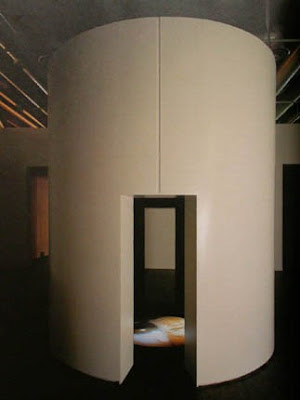Mona Hatoum at The New Museum
The oeuvre of Mona Hatoum evokes a landscape peopled by absence. On many levels, the ideas of intimacy and vulnerability inhabit her work. She often uses images representing intimacy, such as a bed, to illustrate this. But the messages of her work are not bound to a single object. They take,the form of whatever material her interests follow. In one installation, Hatoum employs a video of the inner orifices of her body. Her works are visual, tactile, and in the words of one critic, corporeal. For what Hatoum's work lacks in an actual human presence is instead represented through metaphoric objects projecting a gestalt of vulnerability and loss, of intimacy and defensiveness or distance, a foreshortening of the desire to either remain intimate, or to iinitiate the process of trust and risk, by which intimacy develops.
In Quarters (1996), a set of four five high metal bunk beds face each other in the shape of a cross. I think that this design is only incidental to the space of the installation, and to the formal elements which determine its effect, one of a complex structure of bars, yet minimal, producing an amibiguous signification of the work's title. Stripped of their local character, of all trappings of the physical connection to place, they attain a ghostly immanence. Their spareness and grand scale create a sense of ambiguity and physical paradox for the viewer. The spatial structures affect us, says Guy Brett, both optically and corporeally...to make us waver constantly between a sense of beauty and anxiety. Quarters evokes a historical sensibility in terms of the objects themselves, and one which expresses the sense of an figurative opacity. I say figurative because this opacity inhabits her sculptures and installations as if it were the physical remains or the disembodied spirit of a real person, a virtual presence which both adds and subtracts levels of trust according to its own dictates.


Similarly, yet on another grade of experience altogether, we have Corps Etranger (1994), a video collage made from interior views of the artist's own bodily orifices, into which have been plunged a tiny camera on the end of an infinitesimally small cord. The video is played alongside an intense soundtrack and is housed inside a towering room with beveled portals. Projected upon a wide sloping round screen, like the cornea of an eye, it presents to us as we cluster around the view, with a chasm of unknown depth. The artist's willingness to expose herself for the sake of an experience mirrors the nocturnal fear of failing off a high precipice, or into a dark pit, and to continue falling without reference of horizon or solid ground. The "strange body" or "foreign body" of the title is the interior landscape of our bodies removed from any sense of its perceptual exterior. Of course, it could also refer to ourselves as spectators, as being made virtual visitors in the realm of the artists' body. We are the foreign agents deposited into the blood or airstream of a realm which, in its structural and functional unity, dissociates all other elements that are introduced into it. The inside of the body is a strange landscape, and we are stranger for our immersion within it.
Another theme that has been said to run through Hatoum's work is the creation of installations or objects which contain an element of danger. Hatoum realizes that of all the modes of perception available to us as human beings, that which is connected to our highest dictate, self preservation, ensures the highest levels of self awareness. The range of expressivity in her work related to this intent is varied and determined by the physical aspects of each independent piece. Pin Carpet (1995) seems like any other carpet, another object of bourgeois domesticity raised to the level of an art object—until we look closely, and see that the mass of threads comprising its surface, which we had imagined to be warm and comfortable, are instead aan extremely fine grade of tiny, sharp nails which would pierce our skin at the slightest touch. But whatever the danger, the skein of imposed meaning in these pieces seems worth the risk.
December 4, 1997 - February 22, 1998
NY ARTS MAGAZINE #17, January-February 1998
Comments